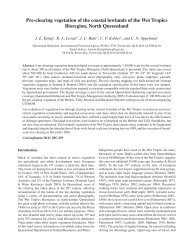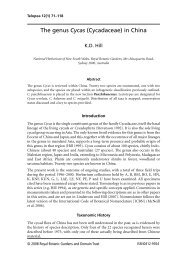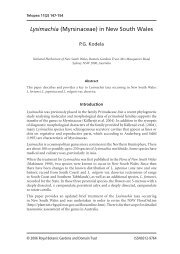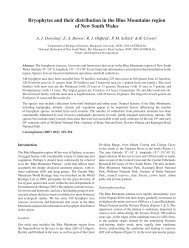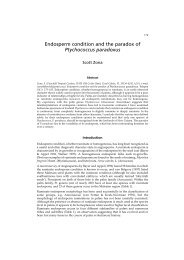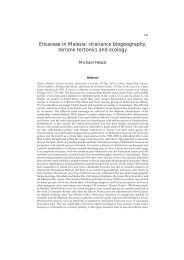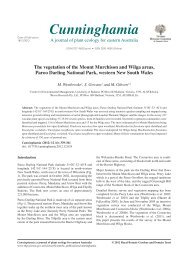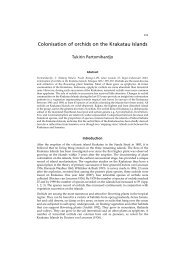Silene banksia - Royal Botanic Gardens
Silene banksia - Royal Botanic Gardens
Silene banksia - Royal Botanic Gardens
Create successful ePaper yourself
Turn your PDF publications into a flip-book with our unique Google optimized e-Paper software.
Mabberley, <strong>Silene</strong> <strong>banksia</strong> (Caryophyllaceae) 251<br />
flore in herbaceum abicante…petalis dentatis, apiculis cinereis. Eadem flore albo’,<br />
included in L. coronata by Thunberg. Zuccarini (in Siebold & Zuccarini 1835–41) noted<br />
that this flowered in May and June (hence the name ‘cut summer gauze’ of Steward<br />
(1958: 113)).<br />
A second plant described on the same page in Kaempfer’s book, ‘Literatis & vulgo<br />
Senno. Lychnis coronaria, foliis calycibus lanuginosis, flore dilutiori sanguineo, petalis<br />
laciniatis, apicibus colore violaceo saturatis’, which Thunberg had as L. chalcedonica,<br />
was included in L. senno of Siebold & Zuccarini, who noted that it flowered in July and<br />
August (therefore the ‘cut autumn gauze’of Steward (1958: 113)). It was also described<br />
from cultivated plants collected in Japan, where, like L. coronata (as L. grandiflora),<br />
Siebold and Zuccarini (1835-41: 97, t. 48 — ‘Colitur frequens in Japoniae hortis’)<br />
considered it not to be wild but probably introduced from China, having been<br />
described by Chinese writers. To L. senno Tang (1996) has joined L. bungeana, which<br />
was collected in a Beijing garden by Bunge and was distributed as seeds by Fischer,<br />
from St Petersburg, those received at the Horticultural Society in London in 1835 being<br />
the origin of the plant figured by Lindley in the <strong>Botanic</strong>al Register (see below). Lindley<br />
noted it was ‘very like a one-flowered state of L. fulgens’, though it was first described<br />
as Agrostemma bungeana by David Don, based on a plant grown in England from seeds<br />
sent from Germany.<br />
Lychnis fulgens, the other parent of L × haageana, is maintained as distinct from L. senno<br />
by Tang (1996). L. fulgens was originally distributed from the Gorenki garden in<br />
Russia, again by Fischer, and a plant raised from seeds in 1819 by Thomas Jenkins in<br />
his nursery in New Road, Marylebone, London, was illustrated by Sims in the<br />
<strong>Botanic</strong>al Magazine (see below). The commonly grown form often has several-flowered<br />
heads, unlike the original description of L. fulgens, which was based on a plant<br />
‘floribus solitariis’, grown in the botanic garden in Berlin; L. fulgens is said to be native<br />
in Siberia, but Tang (1996) records it for China too, with L. senno (including<br />
L. bungeana) also in both.<br />
Quite independent of the work on these Japanese and European cultivated plants, a<br />
specimen of L. coronata in China was described by the Portuguese missionarynaturalist,<br />
João de Loureiro (1717–1791) as Hedona sinensis, another name based on a<br />
cultivated plant, ‘Colitur ob venustatem Cantone Sinarum’. Indeed, the plant had long<br />
been grown in China, figuring in ‘The Hundred Flowers’ of seventeenth-century<br />
painters (e.g. Wiedner et al. 1988: Cat. 34) but was accurately depicted much earlier,<br />
being drawn by Xu Xi in the Five Dynasties (Tenth Century) as reproduced by She &<br />
Yuhas (1973: fig. 4).<br />
Shortly after Loureiro’s work, a very similar form with brick-red flowers was<br />
described as Agrostemma <strong>banksia</strong> Meerb. (1798), a name based on yet another cultivated<br />
plant, this time grown in Leiden, Netherlands, where Nicolaas Meerburg[h]<br />
(1734–1814) was curator of the Hortus <strong>Botanic</strong>us from 1774 until his death. Later, in the<br />
nineteenth century, the plant was described afresh, yet again from cultivated material,<br />
this time in France (Carrière 1871), from a plant grown from ‘oillet’ seeds sent by a M.<br />
Coullet from Yokohama, Japan in 1867. Of that batch only one seed germinated but,<br />
within two seasons of selfing, a whole range of colour forms including white with<br />
variously incised petals were produced. While describing it as new, Elie Carrière<br />
(1818–1896) admitted it might merely be a robust form of the well known cultivated<br />
plant, suggesting that it and L. haageana might merely be forms of ‘L. grandiflora’<br />
(i.e. L. coronata).





